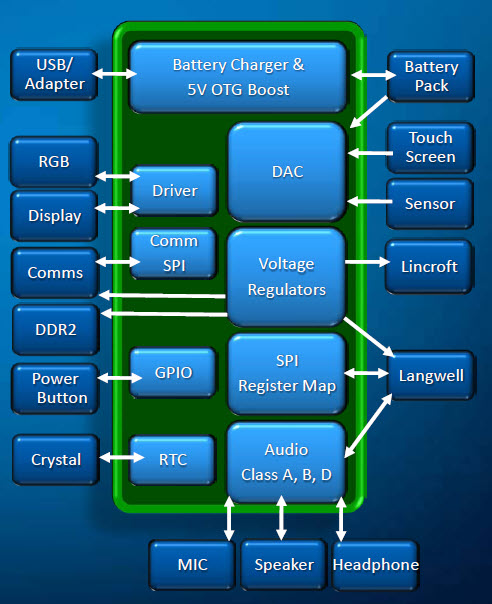Meet Moorestown: Intel's Atom Platform For The Next 10 Billion Devices
Intel’s second-gen Atom platform, Moorestown, positions the chip giant to have a killer smartphone and MID platform in 2010. The old Atom Z5xx drawbacks seem fixed. Why does Moorestown rock, and will it be enough to let Intel advance in this market?
Briertown Mixed Signal IC
Briertown may seem like the extra wheel of the Moorestown platform, but its role is critical for Intel hitting the necessary power targets. There is no one official Briertown design. Rather, Briertown is an architecture specification for peripheral support and power delivery, including battery charging now managed by hardware instead of software. Look at Briertown on a Moorestown motherboard and you’ll see that it’s considerably larger than the CPU and chipset combined. Despite this, Briertown requires almost half as many components and consumes about one-third the board area as the equivalent power delivery circuitry on Menlow platforms. Not surprising, Briertown also costs about one-third the price of its predecessor.
The MSIC is part of what makes Moorestown’s power gating possible. The Briertown complex runs multiple voltage rails to the CPU and chipset, all of which can be controlled by the operating system. Without this, there couldn’t be Lincroft’s Burst Mode because Briertown is what enables those lightning-quick transitions in and out of the various C- and S0ix-states.
Briertown manages device and subsystem power delivery at the system level, each of which get integrated as “jellybeans” within the larger complex in order to keep management more granular. For example, the TPM block occuplies about 6 x 6 mm and consumes up to 85mW. The USB OTG block from Philips measures 20 x 14 mm, consuming about 300mW, and the 2MP USB camera chip from ST Micro measures 7 x 8 mm and draws roughly 400mW.
One can wonder if the Moorestown devices we see at mid-year will be as power-efficient as the knock-off brands and designs we’re likely to see several months later. Intel was emphatic about the fact that when it comes to its new power states, hardware management technologies, and Briertown design, there is no room for flexibility. The platform must hit certain minimum performance levels, and Intel isn’t willing to compromise on this. We may see more “cost-effective” products creep into ODM designs over time, but it won’t be from modification of Intel’s core platform. How much impact future OEM corner-cutting will have on final power and performance levels remains to be seen.
Get Tom's Hardware's best news and in-depth reviews, straight to your inbox.
Current page: Briertown Mixed Signal IC
Prev Page Langwell Platform Controller Hub MP20 Next Page The Experience-
yannifb Huh, i wonder how this will compete with Bobcat, which supposedly will have 90% of desktop chip performance according to AMD.Reply -
descendency Why isn't this a 32nm product yet? If your concern (which it would be with said devices) is power consumption, shrinking the die can only help...Reply -
Greg_77 silverx75Man, and the HTC Incredible just came out....Man, and I just got the HTC Incredible... ;)Reply
And so the march of technology continues! -
well we can only wait till amd gets their ULV chips out with their on die graphics so we can get a nice comparison.Reply
-
williamvw descendencyWhy isn't this a 32nm product yet? If your concern (which it would be with said devices) is power consumption, shrinking the die can only help...Time to market. 45 nm was quicker for development and it accomplished what needed to get done at this time. That's the official answer. Unofficially, sure, we all know 32 nm will help, but this is business for consumers. Right or wrong, you don't play all of your cards right away.Reply
-
seboj I've only had time to read half the article so far, but I'm excited! Good stuff, good stuff.Reply -
burnley14 This is more exciting to me than the release of 6-core processors and the like because these advances produce tangible results for my daily use. Good work Intel!Reply -
ta152h Do we really need x86 plaguing phones now? Good God, why didn't they use a more efficient instruction set for this? Compatibility isn't very important with the PC, since all the software will be new anyway.Reply
I like the Atom, but not in this role. x86 adds inefficiencies that aren't balanced by a need for compatibility in this market.
